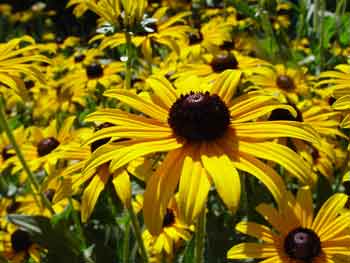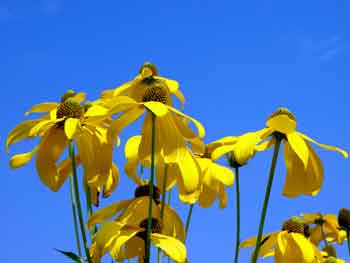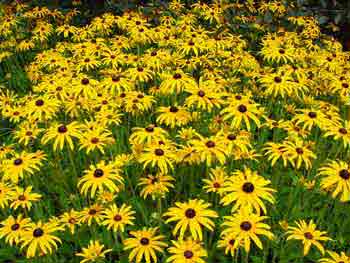Rudbeckia - Coneflowers - Hardy Herbaceous Perennials
If I could only have one single yellow flowered perennial in my garden, then it would be a Rudbeckia. In fact, it would be Rudbeckia fulgida ‘Goldstrurm’. Or maybe if I wanted more height it would be Rudbeckia ‘Herbstonne’ , or maybe…………… I like the Rudbeckias – the golden Coneflowers!
The hardy perennial Rudbeckia group can be planted almost anywhere in the garden and in a wide range of soil types with the only exception being boggy ground. I have seen them growing well in light dappled shade, even a woodland garden, and of course absolute full sun.
It would probably be easier to list where it does not like to grow. Ok – here goes. It is not too happy in dark shade or heavy clay soils, but the annoying thing is, that it will still put on a little show for you.
Habit of Growth.
Most of the Rudbeckias we deal with on this page – herbaceous perennials - are fully hardy. In they are very hardy plants that form a clump of foliage out of which springs the flowering stems of various lengths depending upon variety.
The leaves of all are dark green and lance shaped which die down in the autumn and start into re-growth the following spring.
 The
golden yellow flowers - ‘Goldsturm’ translates roughly into ‘storm of
gold’ – are produced singly at the top of the flowering stems. Flowers
of the hardy Rudbeckias tend to droop slightly – giving rise to the
common name of Coneflower. Before you put finger to email, I
realize that the Echinacea is also called Coneflower. Such is the
delight and vagaries of common names.
The
golden yellow flowers - ‘Goldsturm’ translates roughly into ‘storm of
gold’ – are produced singly at the top of the flowering stems. Flowers
of the hardy Rudbeckias tend to droop slightly – giving rise to the
common name of Coneflower. Before you put finger to email, I
realize that the Echinacea is also called Coneflower. Such is the
delight and vagaries of common names.
Echinacea were also classed as Rudbeckia for a while, and of course they both belong to the same family as most ‘daisy’ flowers – Asteraceae, which again at one time was named Compositae. I only mention this unimportant fact in case you pick up an old gardening book – or listen to an old gardener who is still rooted in the past! The centre of the flowers of all the hardy Rudbeckias are slightly raised and domed. Even moreso with the variety ‘Herbstonne’.
 Position
them in the garden wherever you want a bright spot for the several
months of summer into late autumn. The flowers take on a deeper gold in
the autumn – maybe because of the autumn light! They are perfect border
plants and also make a fine solitary lawn bed – maybe surrounded with
Lavenders or similar.
Position
them in the garden wherever you want a bright spot for the several
months of summer into late autumn. The flowers take on a deeper gold in
the autumn – maybe because of the autumn light! They are perfect border
plants and also make a fine solitary lawn bed – maybe surrounded with
Lavenders or similar.
Propagation of Rudbeckia
Hardy Rudbeckias can be raised from seed, but they differ from the Rudbeckias normally sold by seed of Autumn Shades and Rustic Dwarfs etc. Make sure that the seed stipulated Hardy Perennial. The others are annuals.
 The
easiest way to get a few more plants is to divide the established crown
in late autumn – or better still – early spring. These can be planted
out immediately in their new growing flowering position.
The
easiest way to get a few more plants is to divide the established crown
in late autumn – or better still – early spring. These can be planted
out immediately in their new growing flowering position.
Problems with Rudbeckia
Slugs of course are always after a tasty snack. The young and emerging shoots of Rudbeckia can supply that for them. Otherwise, they seem to have no insect pests.
One thing I have noticed is that toward the end of summer, some of the leaf edges tend to show a little browning. I have not found any fungal disease that causes this. Probably just an acceptance that summer is ending!
Good Varieties of Perennial Rudbeckias.
Rudbeckia fulgida var. sullivantii ‘Goldstrurm. (Image top) This grows to around 60cm tall and forming a clump of foliage 60cm across, with shorter flower spikes than some. ‘Goldsturm’ has a mass of ‘black eyed Susan’ type flowers and deep gold. It is trouble free and as reliable as they come.
Rudbeckia fulgida ‘deamii’ (Image Bottom) is similar, but with hairy foliage and pointed lanceolate leaves.
Rudbeckia ‘Herbstonne’ (Image Centre) I first saw growing in a shaded spot of a shrub border. It was all os 2m – 6ft –tall, and happy with its situation. The flowers – on long stems – are more yellow than the gold of the first two. It is nonetheless attractive. This one spread a little with underground rhizomes but is not invasive – simply easier to divide and multiply your stock! It is later flowering than either R. Goldsturm or R. deamii. Probably the reason it also has the common name of Autumn Sun.
Best Selling Gardening Products
Popular Gardening Sections

Problems
Identify Weeds in The Garden - How to deal with weeds. Diseases and Pest which harm your garden and plants, learn how to prevent, deter and erradicate your garden problems.
Garden Problems
Pruning
Pruning Guide. Shrubs flower better with correct pruning. Many illustrations and examples of what to do - and when. Includes evergreens, roses, flowering shrubs, spring flowering shrubs and pruning for stem effect. This is our most viewed and comprehensive section,
Pruning
Gardening Businesses
Gardening Businesses listed in the UK counties and USA states. County and State Listings of businesses involved in Garden supplies and services. If you wish to be added to the Directory, please send us your information. Having problems, use the search box
Businesses
Gardening
In this section you will learn about Gardening Basics, Containers, Landscaping, Propagation and Soil.
Gardening
Gardening Gifts
Gardening Gifts and Reviews, Read Before you Buy
- Gardening Gifts Ideas
- Gifts For Her
- Gifts For Men
- Power Tool Gifts
- Cheap Gifts
- Personalised Gifts
- Wildlife Gifts
- Family Gifts



